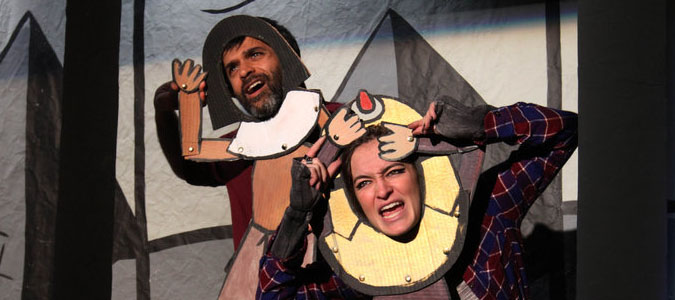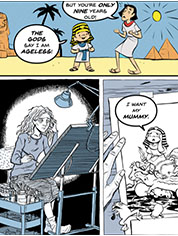

The Tomb of King Tot
Opening Night: June 14, 2016
Closing: June 21, 2016
Theater: The Wild Project
An ambitious regionally-syndicated cartoonist gets good news (she’s a finalist for an award!) and bad news (her daughter did something very, very terrible). Life and comic strip, hilarity and pain converge, then rupture. Inspired by the funnies, Richie Rich, and the Egyptian Book of the Dead.
BUY TICKETSREAD THE REVIEWS:
June 14, 2016
Confining life to four pen-and-ink panels won’t keep the demons at bay. The three-dimensional world has a willful way of creeping into and subverting the two-dimensional comic strip at the center of “The Tomb of King Tot,” the sweet and spiky new tragicomedy by Olivia Dufault, which opened on Tuesday night at the Wild Project as part of Clubbed Thumb’s Summerworks festival. The same invasive process could be said to be the ruling dynamic of this latest offering from the inventive author of “Year of the Rooster,” the 2013 cult hit presented from the perspective of a jittery bird bred for cockfighting. As directed by Portia Krieger, with sets by Carolyn Mraz, “King Tot” the play is often hard to distinguish from the comic strip of the same name, which is penned by an insular and obsessive New Englander named Jane Haley (Annie McNamara). Ms. Dufault’s characters, like those drawn by Jane, at first come across as paper-thin and too precious by half, summoned into existence for the sake of punch lines that usually take the form of seriously lame puns. These seeming stick figures provide an instant, Cap’n-Crunch-flavored nostalgia rush for those who grew up devouring the funny pages along with their cereal every morning and now feed their addiction as grown-ups by watching Adult Swim and “The Simpsons.” Like such animated television fare, “King Tot” exists in a precisely regulated, self-contained universe, with its own laws of physics, geography and anatomy. The five pitch-perfect cast members assembled here often suggest how Homer and Marge, or the fretful souls of a Roz Chast illustration, might function if they were translated into flesh and blood. This is true, even — and especially — of Ms. McNamara’s bendy-bodied, bespectacled Jane, whose expressions and postures exude the effect of deft, single-stroke line drawings of antic attitudes frozen in midgesture. At times, she seems far less fluid than her beloved fictional creations, King Tot (Bianca Crudo), a tantrum-prone 9-year-old ruler of ancient Egypt, and his long-suffering and devoted slave, Horemheb (Nick Choksi). It is these two who open the play, moving among the three comic-striplike windows that form the back of Ms. Mraz’s rendering of Jane’s living room. They have jointed puppet bodies (Tilly Grimes did the costumes) and converse in dialogue that is typically an elaborate, shaggy-sphinx setup for the thudding joke of the final frame. Those jokes are truly terrible. (Example: Tot tells Horemheb he would like a new set of shoes to be made from the bodies of slaves. What would they be called? “Mandals.”) But they are sources of endless delight to Jane, who is first discovered rolling with merriment — in the aisle of the theater – as she admires what she hath wrought. You don’t have to look far for Jane’s immediate sources of inspiration. The same performers step out of the frame to morph into the other residents of Jane’s home. Ms. Crudo doubles as Jane’s perverse, demanding 16-year-old daughter, Atlanta — who gets her thrills from the toxicity of the permanent markers she uses to adorn her body — while Mr. Choksi rematerializes as Porter, Jane’s too-obliging doormat of a partner. True to her artistic breed, Jane spends more time with her imaginary family than her real one, especially once she receives a letter announcing she is a finalist for the coveted Chuckling Willow, “the single most important award for cartoonists in all of Eastern New England.” It is given by the venerable Lionel Feather (Brad Bellamy), “the laugh master of New Hampshire!,” and puts Jane in direct competition with her devious frenemy, Kissy Candida (Carmen M. Herlihy). So far, so cute, right? Or as Kissy, who drops in on Jane unexpectedly, squeals in pleasure: “Oh my gosh, oh my gosh. So much whimsy!” But whimsy, it turns out, comes in black as well as brighter hues. Soon the shadow of darkest tragedy falls over Jane’s world. (It assumes the physical form of spilled ink.) Ms. Mraz, who is great at finding visual equivalents for Jane’s assorted fancies, comes through big time here. Jane responds by digging ever deeper into her work and ignoring the solemn social duties that life has thrust upon her. “The Tomb of King Tot” is no longer the lighthearted strip it once was, though. Its tone becomes increasingly morbid, and imagery from the Egyptian Book of the Dead starts to play a significant role. Animating an artist’s work to mirror her (or his) life is by no means uncommon in theater. (The Tony-winning musical “Fun Home,” adapted from Alison Bechdel’s graphic novel, comes to mind.) Ms. Dufault’s variation on the theme, however, is strikingly bold and assured. The sensibility that shapes both her play and Jane’s comic strip are pretty much identical. Even this work’s signal tragic event is drawn with the fey, absurdist details of comic-book ontology. A naked corpse, for instance, is discovered wearing Tweety Bird socks, and a truck at the scene of the crime is festooned with a sticker showing a Celtics mascot urinating on the Statue of Liberty. Such descriptions may cause you to echo, less gleefully, Kissy’s cry about “so much whimsy.” But this production makes a case for whimsy as a filter both for shutting out and eventually coming to terms with an unforgiving world and one’s unforgivable self. All religions that allow people to press on through this old vale of tears are ultimately personal. “King Tot” suggests that packaging such beliefs in a dopey comic strip doesn’t make them any less useful, improbable or profound.
READ THE REVIEW


















